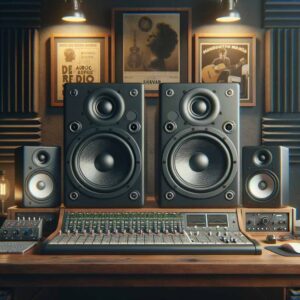Are you wondering how to use a SPDIF input and output on an audio interface?
In this post, we’ll explain how to use a SPDIF audio interface to expand your inputs and outputs.
We’ll also provide a list of the six audio interfaces with SPDIF under $600.
Overview
You can use a SPDIF connection to send digital audio signals from one device to another. It can transmit a digital audio signal without converting it to an analog signal.
As a result, your digital audio signal quality is not degraded when transmitted through SPDIF.
6 SPDIF Audio Interfaces
- Native Instruments Komplete Audio 6 Mk2
- Focusrite Scarlett 8i6
- Focusrite Scarlett 18i8
- PreSonus Studio 68c
- PreSonus Studio 1810c
- PreSonus Studio 1824c
What is SPDIF
SPDIF (Sony/Phillips Digital Interface Format) is a type of connection digital audio connection found in many audio interfaces and other audio devices.
SPDIF inputs and outputs send and receive digital stereo signals to and from another device with SPDIF.
They can transmit audio signals between devices without converting analog signals into a digital format.
Therefore, S/PDIF is a lossless format, meaning that it does not compress or degrade the quality of digital audio signals while transferring them.
If you’re familiar with how audio interfaces work, they convert incoming analog audio signals (from mics, guitars, etc.) into a digital format that your computer can use.
This conversion can potentially alter the sound quality of your audio. But, a SPDIF connection can transfer signals without the need for analog-to-digital conversions.
SPDIF Cable
You can use a SPDIF cable – not to be confused with an RCA cable – for SPDIF connections.
The difference between SPDIF and RCA cables is SPDIF cables transfer digital signals while RCA cables deal with analog signals.
There are two main types of S/PDIF cables: coaxial and optical.
Coaxial S/PDIF cables are shielded to prevent interference from other electronic devices.
Conversely, optical S/PDIF cables use light to transmit the digital audio signal and are not susceptible to interference.
How to Use a SPDIF Audio Interface
To link two SDPIF audio interfaces, all you need is a SDPIF cable.
Then you can sync your devices and assign your inputs and outputs to SPDIF.
One of your interfaces will be your “Master device.”
How to Connect Two SDPIF Audio Interfaces in 5 Steps
- Connect the SPDIF output on one of your interfaces to the SPDIF input on the other using a SPDIF cable.
- Open the software control panel that comes with your interfaces.
- To ensure that all your tracks play back at the same speed and in sync, set each device’s sample rate to be identical (44.1 or 48kHz)
- In your control panel settings for your Master device, set the clock source to “Internal Clock.”
- Set the clock source to “SPDIF” for your other device
Once you connect your devices and sync them through your software, you’re good to go.
SPDIF Limitations
Most devices can only support two channels of S/PDIF.
Also, keep in mind that the maximum sample rate you can record at with SPDIF is 48kHz.
Consider an audio interface with an optical ADAT connection if you wish to record at higher sampling rates.
With ADAT, you can typically add two channels at up to 192kHz, four at up to 96kHz, and two at up to 48kHz.
The Best Budget SPDIF Audio Interface
Native Instruments Komplete Audio 6 Mk2

The Komplete Audio 6 Mk2 is a 6-input/6-output audio interface featuring 192kHz at 24-bits audio converters, transparent low-noise preamps, and advanced direct monitoring features.
Design and Controls
On the front of the Mk2, you’ll find two combo XLR/TRS inputs with corresponding gain controls and line and instrument switches. You’ll also see a button to enable phantom power.
Next, there’s a Monitor Mix knob with two separate switches to enable direct monitoring in stereo or mono and for channels 1-2 and 3-4.
The Komplete Audio 6 Mk2 has two ¼-inch headphone outputs with corresponding volume controls.
On the top are several LED level meters and indicators along with a main output volume knob.
Lastly, there’s a USB-B port, a MIDI IN and OUT, a SPDIF IN and OUT, two sets of ¼-inch outputs, and two ¼-inch line inputs.
The Komplete Audio 6 Mk2 is a great all-in-one audio interface with all the features you need to record, mix, and produce music – including free Cubase DAW software and a host of plugins and VSTs.
It doesn’t have the best build quality, but it delivers clear sound and is very easy to use.
If you’re looking for an affordable and comprehensive interface with SPDIF connection, the Komplete Audio 6 Mk2 is a great option.
Pros:
- SPDIF I/O
- Great for large recording sessions
- Monitor mix in mono and stereo
- Software bundle
- Clear preamps
- Easy to use
Cons:
- Plastic chassis
[Check out our in-depth review of this audio interface here]
Top 5 SPDIF Audio Interfaces Below $600
Focusrite Scarlett 8i6

Focusrite Scarlett 8i6 is a professional quality audio interface that allows you to record and monitor larger recording sessions easily.
It has two natural-sounding microphone preamps, six-line inputs, four analog outputs, two headphone outputs, and digital I/O.
The Focusrite Scarlett 8i6 also includes MIDI I/O to connect a keyboard or vintage MIDI controller.
It’s compatible with Mac and PC and has a nice software bundle to help you start recording immediately.
Pros
- Digital I/O
- Air mode
- Excellent recording quality
- low-noise preamps
Cons
- You’ll have to control most features through the included software panel, not the interface.
8 Inputs
- Two Combo XLR/TRS inputs
- Four-line inputs
- MIDI IN
- SPDIF IN
6 Outputs
- Four line outputs
- MIDI OUT
- SPDIF OUT
Connection
- USB-C
- 12V DC power
Features
- Air Mode
- PAD
- Phantom power
- Software bundle
Focusrite Scarlett 18i8

The Focusrite Scarlett 18i8 offers the same performance and feel as the 8i6, except it has more analog ins and outs and an optical input that supports up to eight extra channels.
It also features a SPDIF in and out that supports two additional channels for a total of eighteen potential inputs and eight outputs.
18 Inputs
- Four Combo XLR/TRS inputs
- Four-line inputs
- MIDI IN
- SPDIF IN
- Optical ADAT IN (up to eight channels)
6 Outputs
- Four line outputs
- MIDI OUT
- SPDIF OUT
- Two ¼ headphone outputs
Connection
- USB-C
- 12V DC power
Features
- Same as the Scarlett 8i6
PreSonus Studio 68c

If you’re in the market for a relatively affordable yet high-quality audio interface, the PreSonus Studio 68c is worth considering.
This 6-in/6-out interface features excellent sound quality, thanks to its 24-bit/192kHz converters, and comes with a comprehensive software bundle that includes PreSonus’ Studio One 3 Artist DAW.
Regarding connectivity, the Studio 68c features two combo mic/instrument inputs (with 48V phantom power), four line inputs, two main outs, and two line outs.
It also has MIDI I/O and a headphone output with a volume control.
Overall, the PreSonus Studio 68c is a great option for those looking for a detailed level meter to help set gain and monitor recording levels.
Pros
- Excellent sound quality
- Comprehensive software bundle included
- LED level meters
- Crystal-clear X-MAX-L mic preamps
Cons
- No major cons
PreSonus Studio 1810c and 1824c

If you’re interested in PreSonus’ Studio 68c but need more inputs and outputs, the Studio 1810c and 1824c are great options.
They come with SPDIF and ADAT connections. The 1810c supports up to eighteen inputs and eight outputs, while the 1824c can expand to eighteen inputs and twenty outputs.
Takeaway: What is a SPDIF Audio Interface?
SPDIF is a type of digital connection found in many interfaces that allow you to expand you input and output count by connecting to another SPDIF interface.
Most units let you add two extra channels at up to 48kHz.
6 Audio Interfaces with a SPDIF I/O are…








